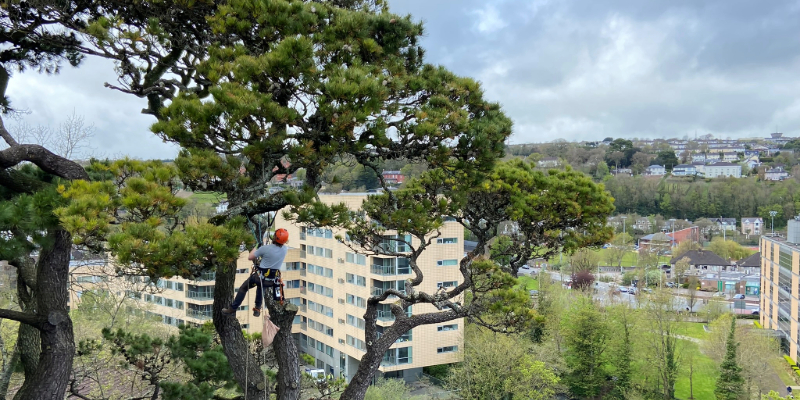Latest News
Ringing ravens on University College Cork's campus

- Ravens nesting on UCC's campus become part of nationwide conservation project.
High above the ground on University College Cork's campus is an active raven nest in a large monterey pine tree, and recently these striking birds became part of a nationwide conservation project.
Ravens are the largest member of the crow family, which also includes rooks and jackdaws, and are the world’s largest songbird. They are intelligent and charismatic birds often appearing in popular culture and literature. Charles Dickens famously had a pet raven, they are believed to guard the Tower of London and they feature as pets in the Harry Potter series of books and films. Their ecology is closely linked with human activity, and they have adapted well to urban landscapes where they nest in very tall trees and buildings, exploiting local food sources including small mammals and insects. They also eat carrion, effectively fulfilling the same role in Ireland as vultures do in other countries.
A national colour ringing project for raven chicks by National Parks & Wildlife Service (NPWS), to allow us to follow their fate and better understand their biology and ecology, is being led in Cork by Conservation Ranger Sam Bayley. The project focuses on colour ringing the chicks so that if they are resighted in the future this information can be used for monitoring purposes and to gain an understanding of their dispersal and longevity. Although ravens are common in the Irish landscape, we still have much to learn about their survival, productivity and movements, and particularly about where the juvenile birds go after they leave their nesting area.
“It was wonderful to find these intelligent and long-lived birds nesting in the city. It was brilliant that UCC allowed us access to add these birds to our project, and for President O’Halloran to be so involved in this important work,” stated Sam Bayley, Conservation Ranger with National Parks & Wildlife Service.
The raven pair on our campus were confirmed to be breeding just a few weeks ago, and yesterday UCC graduate Dr Alan McCarthy expertly scaled the very tall monterey pine tree, under licence, and confirmed that the nest contained two young raven chicks. Ravens are protected by the EU Birds Directive, and it is illegal to disturb their nests without a licence from NPWS.
Alan carefully lowered the two Raven chicks to the ground in special bags where ringers Jess Hodnett, from Fota Wildlife Park, and UCC President Professor John O’Halloran, a ornithologist and licenced bird ringer, were waiting with their kits ready.
Each bird was fitted with a uniquely marked metal ring on one leg which will last the birds lifetime, and with a colour ring on the other leg which enables the bird to be identified from a distance. Together, these identification rings will enable reports of sightings, which will provide information for a database recording the life history of this bird species. Once the leg rings had been fitted the two chicks were safely returned to their nest.
UCC's campus biodiversity recognised
This week, UCC became the first higher education institute in the world to secure a fifth Green Flag. Universities across the world are assessed under eight criteria including environmental management and commitment to biodiversity.
“The extraordinary efforts of students and staff over many years have made UCC the sixth most sustainable university in the world, and this is a wonderful example of the importance of our arboretum to provide habitat for local wildlife,” stated Professor John O’Halloran, President of UCC.
It is expected that these chicks will remain in the nest for a few more weeks when we hope that they will both successfully fledge, and we look forward to seeing and hearing them fly over our campus with their distinctive loud gurgling croak, which is much deeper and more musical than the calls of Rooks or Jackdaws. We look forward to any future sightings which will serve to further our scientific knowledge of this important species and help us to better understand our bird populations.
You can help by reporting any ringed bird you see to BirdWatch Ireland or NPWS.
